Equus sylvestris von den Brincken, 1826
Taxonomy & Nomenclature
Conservation Status
Invalid (synonym)
Distribution
Europe
Biology & Ecology
Hypodigm
Media
References
Equus semiplicatus Cope, 1893
Stiltlegged horse
Taxonomy & Nomenclature
Synonym/s: Onager semiplicatus Cope, 1893
Conservation Status
Extinct if valid
Last record: Late Pleistocene/Holocene
Distribution
Texas, USA
Biology & Ecology
Hypodigm
Media
References
Original scientific description:
Cope, Edward Drinker. (1893). A preliminary report on the vertebrate paleontology of the Llano Estacado. Fourth Annual Report of the Geological Survey of Texas 1892: 11-136.
Other references:
Azzaroli, A. (1998). The genus Equus in North America: The Pleistocene species = Le genre Equus en Amérique du Nord - Les espèces du Pléistocène. Palaeontographia Italica 85: 1-60. [Abstract]
Dalquest, W. W. and Schultz, G. E. (1992). Ice Age mammals of northwestern Texas. Midwestern State University Press.
Gidley, J. W. (1901). Tooth Characters and Revision of the North American Species of the Genus Equus. Bulletin of the American Museum of Natural History 14(9): 1-60.
Hulbert, R. C. (1995). Equus from Leisey Shell Pit 1A and other Irvingtonian localities from Florida. Bulletin of the Florida Museum of Natural History 37(17): 553-602.
Kurten, B. and Anderson, E. (1980). Pleistocene Mammals of North America. Columbia University Press. 442 pp.
Quinn, J. H. (1957). Pleistocene Equidae of Texas. Bureau of Economic Geology, The University of Texas Report of Investigations 33: 1-47.
Smith, F. A., Lyons, S. K., Ernest, S. K. M., Jones, K. E., Kaufman, D. M., Dayan, T., Marquet, P. A., Brown, J. H. and Haskell, J. P. (2003). Body mass of late Quaternary mammals. Ecology 84(12): 3403-3403.
Weinstock J., Willerslev E., Sher A., Tong W., Ho S.Y.W., Rubenstein D., Storer J., Burns J., Martin L., Bravi C. et al. (2005). Evolution, Systematics, and Phylogeography of Pleistocene Horses in the New World: A Molecular Perspective. PLoS Biology 3(8): e241. https://doi.org/10.1371/journal.pbio.0030241
Equus scotti Gidley, 1900
Scott's horse
Taxonomy & Nomenclature
Considered a synonym of E. mexicanus by (Alberdi et al., 2014).
Conservation Status
Invalid?
Last record: Late Pleistocene
Distribution
USA
Biology & Ecology
Hypodigm
Media
References
Alberdi, María Teresa, Arroyo-Cabrales, Joaquín, Marín-Leyva, Alejandro H. and Polaco, Oscar J. (2014). Study of Cedral Horses and their place in the Mexican Quaternary. Revista Mexicana de Ciencias Geológicas 31(2): 221-237.
Cirilli, Omar, Machado, H., Arroyo-Cabrales, J., Barrón-Ortiz, C. I., Davis, E., Jass, C. N., Jukar, A. M., Landry, Z., Marín-Leyva, A. H., Pandolfi, L., Pushkina, D., Rook, L., Saarinen, J., Scott, E., Semprebon, G., Strani, F., Villavicencio, N. A., Kaya, F. and Bernor, R. L. (2022). Evolution of the Family Equidae, Subfamily Equinae, in North, Central and South America, Eurasia and Africa during the Plio-Pleistocene. Biology 11(9): 1258. https://doi.org/10.3390/biology11091258
Croxen et al. 2007. Pleistocene geology and paleontology of the Colorado River Delta at Golfo de Santa Clara, Sonora, Mexico. Pp. 84-89, in Wild, scenic & rapid—a trip down the Colorado River trough (Robert E. Reynolds, ed.). The 2007 Desert Symposium field guide and abstracts from proceedings, California State University, Desert Studies Consortium, and LSA Associates, Inc.
Dalquest, Walter W. (1977). Mammals of the Holloman Local Fauna, Pleistocene of Oklahoma. Southwestern Naturalist 22: 255-268.
Frick, C. 1921. Extinct vertebrate faunas of the badlands of Bautista Creek and San Timoteo Canon, southern California. University of California Publications in Geology 12(5):277-424, plates 43-50.
Harris, A. H. 1987. Reconstruction of Mid-Wisconsin environments in southern New Mexico. National Geographic Research 3:142-151.
Harris, A. H. 1989. The New Mexican late Wisconsin—east versus west. National Geographic Research 5:205-217.
Harris, A. H. 1993. Quaternary vertebrates of New Mexico. Pp. 179-197, in Vertebrate Paleontology in New Mexico, New Mexico Museum of Natural History, Bulletin 2:i-vii, 1-338.
Harris, A. H. 2003. The Pleistocene vertebrate fauna from Pendejo Cave. Pp. 36-65, in Pendejo Cave (R. S. MacNeish and J. G. Libby, eds.), University of New Mexico Press, Albuquerque, 526 pp.
Harris, Arthur H. and Porter, Linda S. W. (1980). Late Pleistocene horses of Dry Cave, Eddy County, New Mexico. Journal of Mammalogy 61(1): 46-65.
Hibbard, Claude W. and Taylor, Dwight W. (1960). Two late Pleistocene faunas from southwestern Kansas. Contributions from the Museum of Paleontology, The University of Michigan 16(1): 1-223 pp., 16 pls., 18 figs.
Hibben, F. C. 1941. Evidences of early occupation in Sandia Cave, New Mexico, and other sites in the Sandia-Manzano region. With appendix on Correlation of the deposits of Sandia Cave, New Mexico, with the glacial chronology. Smithsonian Miscellaneous Collections 99(23): i-vi, 1-(?63+)
Jefferson, G. T. (1991). A catalogue of Late Quaternary vertebrates from California. Part two: Mammals. Natural History Museum of Los Angeles County Technical Reports 7: 1-129.
Matthew, W. D. (1902). List of the Pleistocene fauna from Hay Springs, Nebraska. Bulletin of the AMNH 16: 317-322.
Renders, E. and Vincelette, A. (2023). Methodology for the determination of modern and fossil horse gaits from trackways. Journal of Paleontological Techniques 27: 1-25.
Scott, Eric, Springer, Kathleen B. and Sagebiel, James C. (2017). The Tule Springs local fauna: Rancholabrean vertebrates from the Las Vegas Formation, Nevada. Quaternary International 443(A): 105-121. [Abstract]
Short, Rachel A., Emmert, Laura G., Famoso, Nicholas A., Martin, Jeff M., Mead, Jim I., Swift, Sandy L. and Baez, Arturo. (2021). Paleobiology of a large mammal community from the late Pleistocene of Sonora, Mexico. Quaternary Research. DOI: https://doi.org/10.1017/qua.2020.125 [Abstract]
Springer, Kathleen B., Pigati, Jeffrey S. and Scott, Eric. (2017). Vertebrate Paleontology, Stratigraphy, and Paleohydrology of Tule Springs Fossil Beds National Monument, Nevada (USA). Geology of the Intermountain West 4: 55-98.
Equus santaeelenae Spillmann, 1938
Taxonomy & Nomenclature
Conservation Status
Extinct if valid
Last record: Late Pleistocene
Distribution
Peru
Biology & Ecology
Hypodigm
Media
References
Original scientific description:
Spillmann, F. (1938). Die fossilen Pferde Ekuadors der Gattung Neohippus. Palaeobiologica 6: 372-393.
Other references:
Churcher, C. S. (1985). Equids (genus Amerhippus) from the Sangamon at Medicine Hat, Alberta. In Fourth International Theriological Conference, Edmonton, Alberta, Abstract 0114.
Ficcarelli, G., Coltorti, M., Moreno-Espinosa, M., Pieruccini, P. L., Rook, L. and Torre, D. (2003). A model for the Holocene extinction of the mammal megafauna in Ecuador. Journal of South American Earth Sciences 15: 835-845.
Lindsey, Emily L. and Lopez, R., Eric X. (2015). Tanque Loma, a new late-Pleistocene megafaunal tar seep locality from southwest Ecuador. Journal of South American Earth Sciences 57: 61-82.
Prado, J. L. and Alberdi, M. T. (1994). A quantitative review of the horse Equus from South America. Palaeontology 37: 459-481.
Rincón, A.D., M.T. Alberdi, and J.L. Prado. (2006). Nuevo registro de Equus (Amerhippus) santaeelenae (Mammalia, Perissodactyla) del pozo de asfalto de Inciarte (Pleistoceno Superior), estado Zulia, Venezuela. Ameghiniana 43: 529-538.
Rincón, A.D., R.S. White, and G. McDonald. (2008). Late Pleistocene cingulates (Mammalia: Xenarthra) from Mene de Inciarte tar pits, Sierra de Perijá, western Venezuela. Journal of Vertebrate Paleontology 28(1): 197-207.
Seymour, Kevin L. (2015). Perusing Talara: Overview of the Late Pleistocene Fossils from the Tar Seeps of Peru, pp. 97-109. In: Harris, John M. (ed.). La Brea and Beyond: The Paleontology of Asphalt-Preserved Biotas. Los Angeles, California: Natural History Museum of Los Angeles County, Science Series No. 42. 174 pp.
Turvey, Samuel T. (2009). In the shadow of the megafauna: prehistoric mammal and bird extinctions across the Holocene, pp. 17-39. In: Turvey, Samuel T. (ed.). Holocene Extinctions. New York: Oxford University Press.
Equus quagga quagga Boddaert, 1785:160
Quagga, iqwara (Xhosa), kwagga (Afrikaans)
Taxonomy & Nomenclature
Synonym/s: Equus burchelli quagga Boddaert, 1785:160; couagga Desmarest, 1822; danielli Pocock, 1904; greyi Lydekker, 1902; lorenzi Lydekker, 1902; qouagga Lesson, 1827; quaccha Gray, 1827; trouessarti Camerano, 1908
Conservation Status
Extinct
Last record: 1872 (Gippoliti et al., 2017); 12 August 1883 (Willoughby, 1966)
IUCN RedList status: Extinct
Distribution
South Africa
Biology & Ecology
Hypodigm
The Grant Museum of Zoology:
Z581 (mounted skeleton; female)
Zoologisch Museum, Amsterdam, The Netherlands:
ZMA 522 (died 12 August 1883 at Amsterdam Zoo)
See also (Rau, 1974, 1978).
Media
Early illustrations
Many early illustrations can be seen in (Schlawe & Wozniak, 2010).
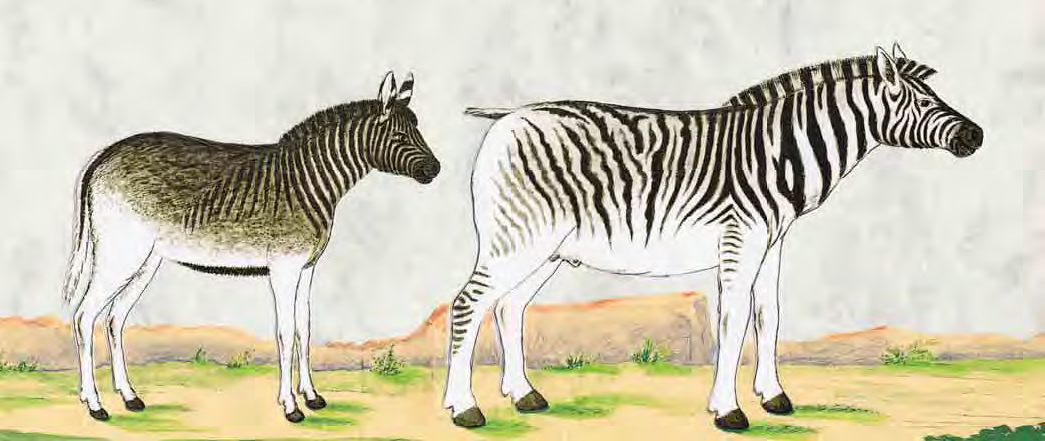
Above: illustration by Robert Jacob Gordon (1777).
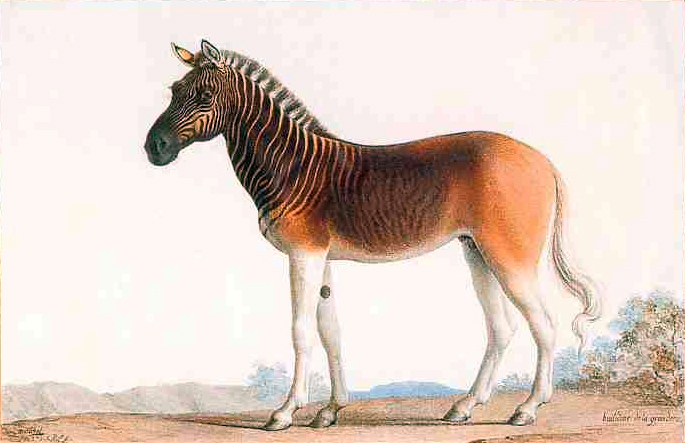
Above: painting of a Quagga stallion in Louis XVI's Versailles menagerie by Nicolas Maréchal (1793).
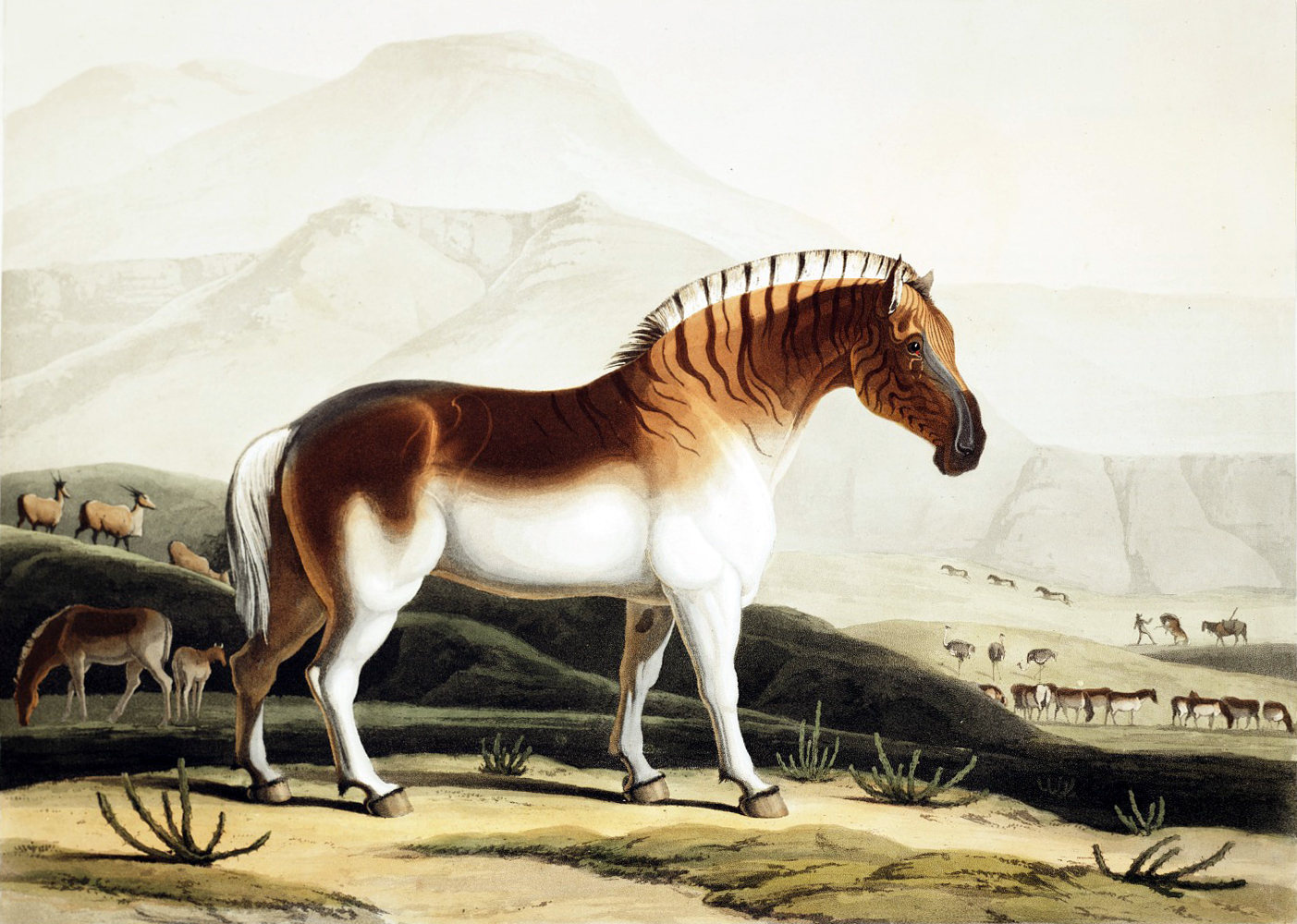
Above: painting by Samuel Daniell later used as the basis of the synonym E. q. danielli (1804)
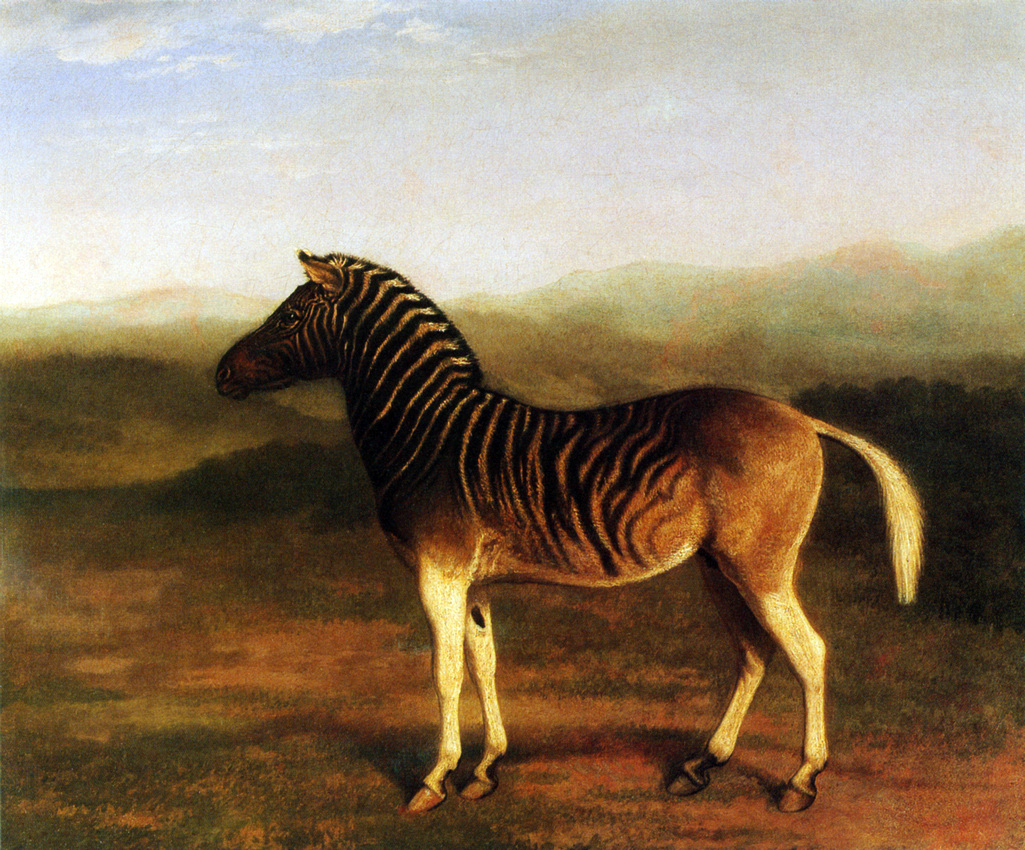
Above: Paintings of a Quagga stallion belonging to Lord Morton by Jacques-Laurent Agasse (1821).
The only African photograph
The only photograph of a live Quagga in its native South Africa was taken by Gustav Theodor Fritsch (1838-1927) on 8 April 1864 at Andrew Hudson Bain's farm (Quaggafontein) in South Africa's Orange Free State (Fritsch, 1868; Barnaby, 1996; Heywood & Dietrich, 2021), but has long been known only via the photoxylographic version (Heywood & Dietrich, 2021).
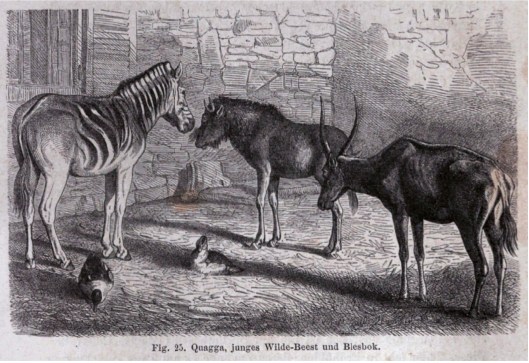
In December 2022, Artist Jasper Hulshoff Pol (website) rediscovered a stereophoto slide copy of Fritsch's original photographic image. He and I have written an article about the discovery:
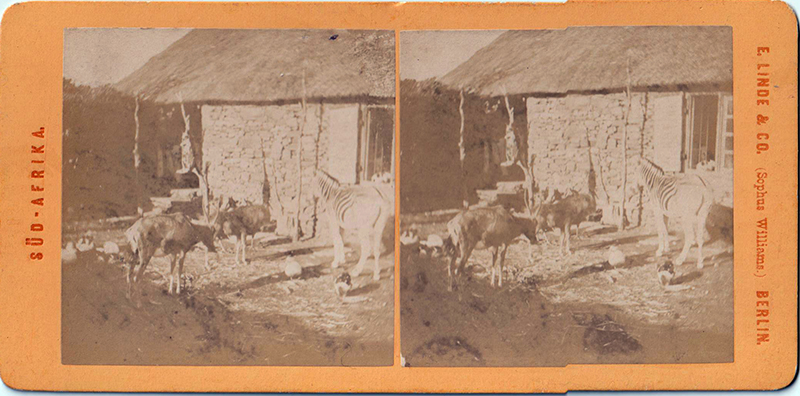
Above: the front of the slide. Kindly provided by Jasper Hulshoff Pol.
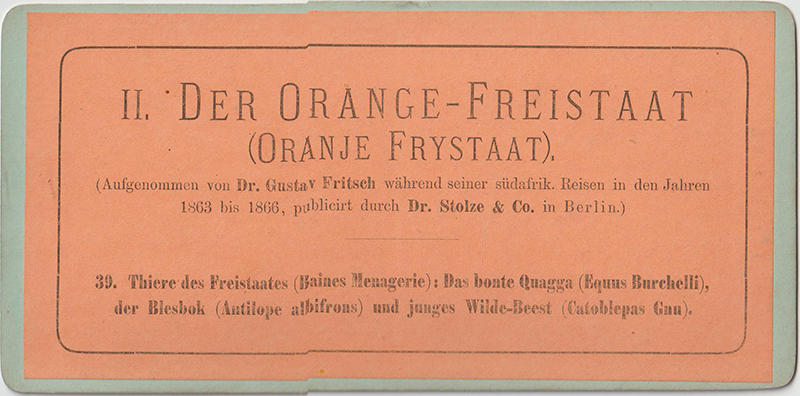
Above: the reverse of the slide. Kindly provided by Jasper Hulshoff Pol.
London Zoo photographs
In addition to the above little known photo, five photographs of one mare in the London Zoo are known, where she resided from 1851-1872. They were taken by Frank Haes (1863-1864) and Frederick York (1870) (Heywood & Dietrich, 2021), but the last of them was only published (and discovered?) more than a century later in 1991 (Huber, 1991, 1994). And even then, the details of the photographs have been made clearer by further research (Edwards, 1996; Fuller, 2013; Heywood & Dietrich, 2021).
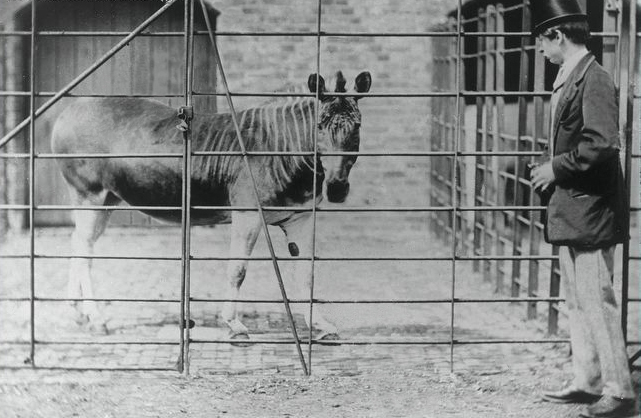
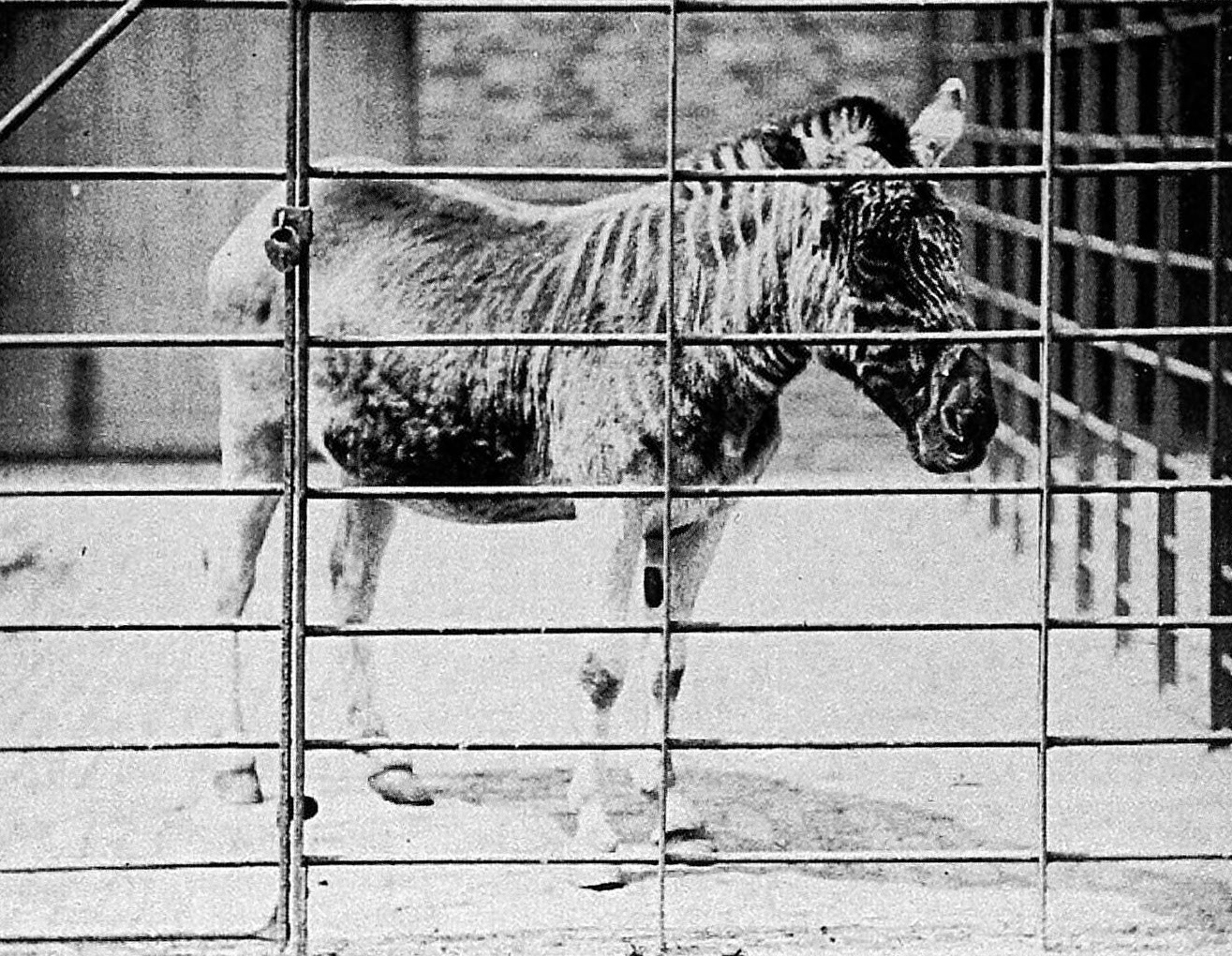
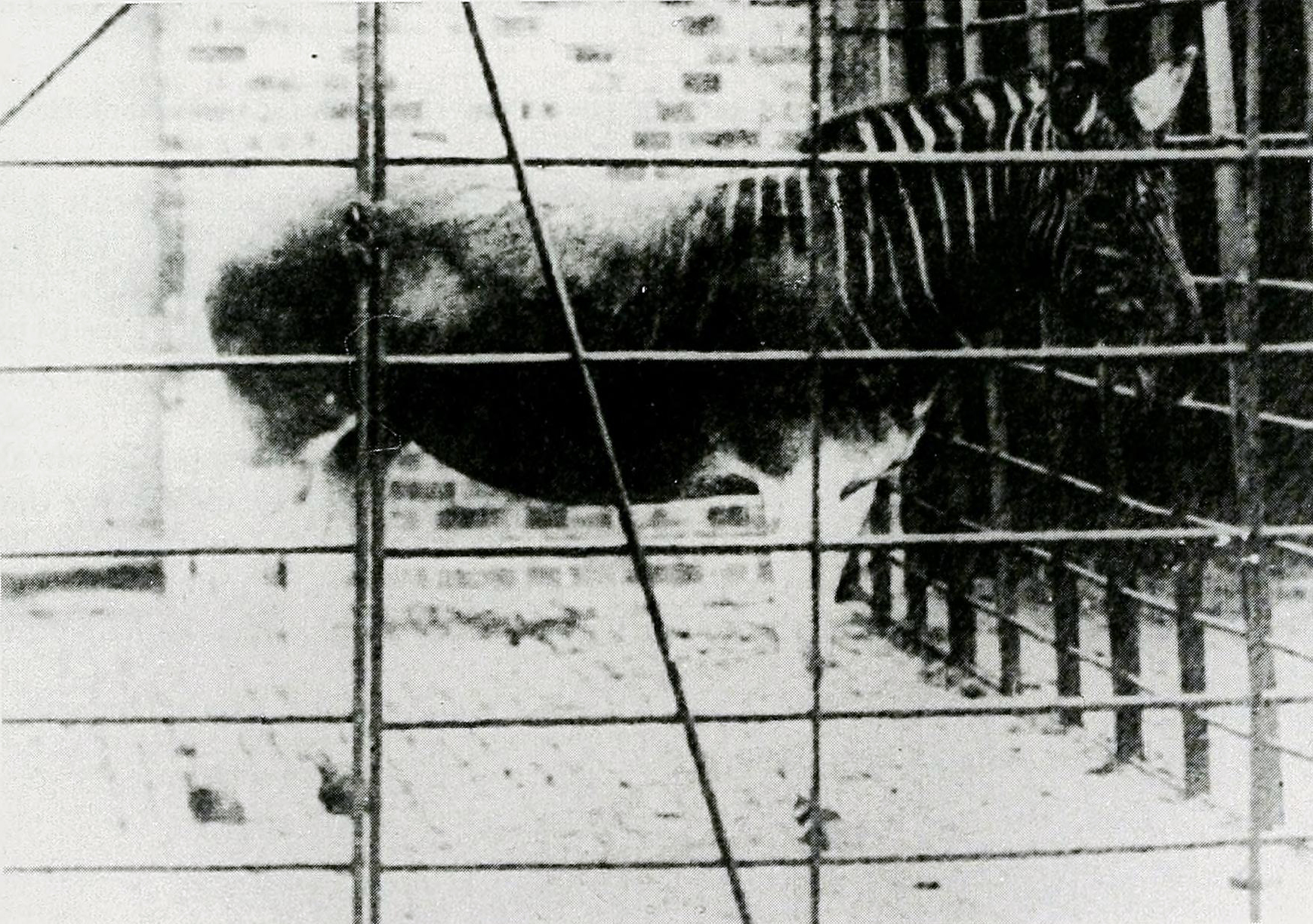
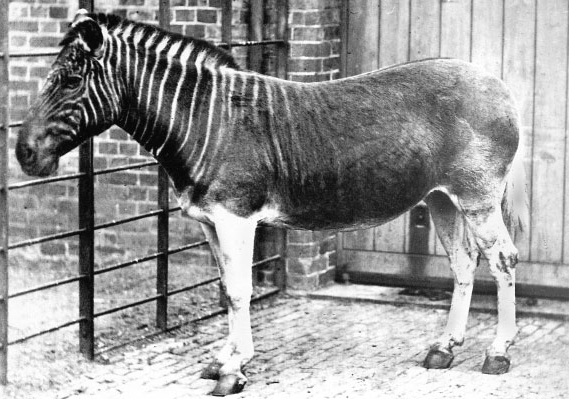
Above: one of two images from the stereoview (see here).

References
Original scientific description:
Boddaert, P. (1785). Elenchus animalium. Volumen 1: Sistens quadrupedia huc usque nota eorumque varietatis. Rotterdam: C. R. Hake.
Other references:
Allen, Barbara. (Due May 2025). Lost Animals, Disappearing Worlds: Stories of Extinction. Reaktion Books. 248 pp, 38 figs.
Anonymous. (1833). List of the animals in the gardens of the Zoological Society: with notices respecting them, and a plan of the gardens, showing the buildings and enclosures in which the animals are kept: June 1833. London: Printed by Richard Taylor. [p. 49]
Anonymous?. (2013). #003 Quagga Skeleton. Biologist 60(4): 46. [Abstract]
Azzaroli, Augusto. (1966). Pleistocene and living horses of the Old World. Palaeontogr. Ital. 61: 1-15.
Azzaroli, Augusto and Stanyon, Roscoe. (1991). Specific Identity and Taxonomic Position of the Extinct Quagga. Rendiconti Lincei 2.4: 425-36.
Barnaby, David. (1996). Quaggas and Other Zebras. Plymouth: Bassett Publications. 114 pp.
D. Barnaby, ‘The Karoo Receives Plains Zebras from the Quagga Project’, International Zoo News, 46, 2, 1999, 94–8.
D. Barnaby, Letters to Mr Tegetmeier from J. Cossar Ewart and Others to the Editor of The Field at the Turn of the Nineteenth Century (Sale, UK: ZSGM, 2004), 26.
W. Beinart, ‘The Night of the Jackal: Sheep, Pastures and Predators in the Cape,’ Past and Present, 158, 1998, 172–206
Bennett, D.K., 1980. Stripes do not a zebra make, part I: a cladistic analysis of Equus. Syst. Zool. 29: 272-287.
Bernor, R.L., Armour-Chelu, M., Gilbert, W.H., Kaiser, T.M., Schulz, E., 2010. Equidae. In: Werdelin, L., Sanders, W.J. (Eds.), Cenozoic Mammals of Africa. University of California Press, Berkeley.
Bertens, Laura M. F. and Wilson, Ann Marie. (2022). Wonder, Empire, Science: The Quagga and Other Extinctions on Display at Naturalis. Museum & Society 20(1): 33-49.
Bienvenue, Valérie. (2022). From the General to the Particular: Piecing Together the Life and Afterlife of A544, Louis XVI's Quagga. In: Bienvenue, Valérie and Chare, Nicholas (eds.). Animals, Plants and Afterimages: The Art and Science of Representing Extinction. Berghahn Books. 460 pp.
Bonner, R. (1993). At the hand of man. Peril and hope for Africa’s wildlife. Alfred A. Knopf: New York. 322 pp.
Boshoff, A. F. and Kerley, G. I. H. (2010). Historical Mammal Distribution Data: How Reliable Are Written Records? South African Journal of Science 106(1-2): 26-33.
Bradfield J, Kitchener AC, Buckley M (2021). Selection preferences for animal species used in bone-tool-manufacturing strategies in KwaZulu-Natal, South Africa. PLoS ONE 16(4): e0249296. https://doi.org/10.1371/journal.pone.0249296
van Bruggen, A. C. (1959). Illustrated notes on some extinct South African ungulates. South African Journal of Science 55: 197-200.
H.A. Bryden, Kloof and Karroo: Sport, Legend and Natural History in Cape Colony, with a Notice of the Game Birds, and of the Present Distribution of Antelopes and Larger Game (London, New York: Longmans, Green, 1889), 401).
Burkhardt, R. W. (1979). Closing the door on Lord Morton’s mare:The rise and fall of telegony. Stud Hist Biol 3: 1-21.
Camerano, Lorenzo. (1908). Il Quagga del Museo Zoologico di Torino. Atti R. Accad. Sci. Torino 43: 562-565.
Cape Argus (South Africa), 8 March 1952 [report of a quagga’s skull valued at £25,000 for sale]
Carp, Bernard. (1952). A quagga chase in South-West Africa. Afr. Wild Life 6: 100-105.
Churcher, C. S. (1986). The extinct Cape zebra. Sagittarius 1: 4-5.
Cirilli, Omar, Machado, H., Arroyo-Cabrales, J., Barrón-Ortiz, C. I., Davis, E., Jass, C. N., Jukar, A. M., Landry, Z., Marín-Leyva, A. H., Pandolfi, L., Pushkina, D., Rook, L., Saarinen, J., Scott, E., Semprebon, G., Strani, F., Villavicencio, N. A., Kaya, F. and Bernor, R. L. (2022). Evolution of the Family Equidae, Subfamily Equinae, in North, Central and South America, Eurasia and Africa during the Plio-Pleistocene. Biology 11(9): 1258. https://doi.org/10.3390/biology11091258
J. Comrie-Greig, ‘The Quagga and the Taxidermist’s Art’, African Wildlife, 37, 4, 1983
Cucchi T, Mohaseb A, Peigné S, Debue K, Orlando L, Mashkour M. 2017 Detecting taxonomic and phylogenetic signals in equid cheek teeth: towards new palaeontological and archaeological proxies. R. Soc. open sci. 4: 160997.
C. Darwin, 1838. Notebook C #145, http://darwin-online.org.uk/content/frameset?keywords=quagga&pageseq=129&itemID=CUL-DAR122.-&viewtype=text
Day, David. (1981). The Doomsday Book of Animals: A Natural History of Vanished Species. New York, N.Y.: The Viking Press.
De Vos, Rick. (2014). Stripes Faded, Barking Silenced: Remembering Quagga. Animal Studies Journal 3(1): 29-45.
Dolan, J. (1981). On an Unpublished Photograph of a Quagga Equus quagga quagga Gmelin, 1788 (Equidae; Mammalia). Zool. Garten N. F., Jena 51(5-6): 357-362.
Dollmann, J. Guy. (1937). Mammals which have recently become extinct and those on the verge of extinction. J. Soc. Preserv. Fauna Empire n. s. 30: 67-74.
Dorst, J. (1970). “Before nature dies”. English translation of: Avant que nature meure, 1965. Wm Collins & Sons: London & Glasgow; Houghton Mifflin Co: Boston, Mass. 352 pp.
Duncan, F. M. (1913). Cassell’s natural history. London: Cassell.
Edwards, John. (1996). London Zoo from Old Photographs: 1852-1914. London: John Edwards. 240 pp.
Eisenmann, Vera and Brink, J. S. (2000). Koffiefontein quaggas and true Cape quaggas: the importance of basic skull morphology. South African Journal of Science 96(9-10): 529-533.
Estes, R. D. (1991). The Behaviour Guide to African Mammals. Los Angeles: University of California Press. 611 pp. [p. 240?]
Faith, J. Tyler. (2014). Late Pleistocene and Holocene mammal extinctions on continental Africa. Earth-Science Reviews 128: 105-121.
Fock, G. J. (1972). Extinct bovine on rock engraving. Researches of the National Museum, Bloemfontein 2: 349-353. [Bushman rock-engravings depicting the Quagga and Pelorovis antiquus]
Freeman, Carol. (2009). Ending Extinction: The Quagga, the Thylacine and the “Smart Human”, pp. 235-256. In: Gigliotti, Carol. Leonardo’s Choice: Genetic Technologies and Animals. New York: Springer.
Fritsch, G. (1868). Drei Jahre in Süd-Afrika. Reiseskizzen Nach Notizen des Tagebuchs zusammengestellt. Breslau (Ferdinand Hirt). 416 pp.
Fuller, Errol. (2013). Lost Animals: Extinction and the Photographic Record. London: Bloomsbury Press. 256 pp.
George, M. and Ryder, O. A. (1986). Mitochondrial DNA Evolution in the Genus Equus. Molecular Biology and Evolution 3(6): 535-546.
Gippoliti, Spartaco. (2024). Four hundred years of studying and collecting African mammals: a review of Italian contributions to African mammalogy. J. of Vertebrate Biology 73(23110): 1-13. https://doi.org/10.25225/jvb.23110
Gippoliti, Spartaco, Cotterill, Fenton P. D., Zinner, Dietmar and Groves, Colin P. (2017). Impacts of taxonomic inertia for the conservation of African ungulate diversity:an overview. Biological Reviews. doi: 10.1111/brv.12335
Gmelin, J. F. (1788). Caroli a Linné, Systema naturae per regna tria naturae secundum classes, ordines, genera, species cum characteribus, differentiis, synonymis, locis. Tomus I, part I. Lipsiae: Impensis Georg. Emmanuel Beer.
Goodwin, Harry A. and Goodwin, J. M. (1973). List of mammals which have become extinct or are possibly extinct since 1600. Int. Union Conserv. Nat. Occas. Pap. 8: 1-20.
R. Gordon Cumming, The Lion Hunter in South Africa: Five Years of a Hunter’s Life in the Far Interior of South Africa (London: John Murray, 1855), 68.
Groves, Colin P. and Bell, C. H. (2004). New investigations on the taxonomy of the zebras genus Equus, subgenus Hippotigris. Mamm. Biol. 69: 182-96.
Grub, Peter. (1999). Types and type localities of ungulates named from southern Africa. Koedoe 42(2): 13-45.
Hack, M.A., East, R. & Rubenstein, D.I. (Equid Specialist Group). (2002). Equus quagga ssp. quagga. The IUCN Red List of Threatened Species 2002: e.T7957A12876343. Accessed on 04 February 2022.
Hack, M. A., East, R. and Rubenstein, D. I. (2008a). Equus quagga ssp. quagga. In: IUCN 2011. IUCN Red List of Threatened Species. Version 2011.1. (http://www.iucnredlist.org). Downloaded on 17 July 2011.
Hack, M.A., East, R. & Rubenstein, D.I. (2008b). Equus quagga ssp. quagga. The IUCN Red List of Threatened Species 2008: e.T7957A12876306. https://dx.doi.org/10.2305/IUCN.UK.2008.RLTS.T7957A12876306.en. Accessed on 04 February 2022.
Harley, E. H., Lardner, C., Gregor, M., Wooding, B. and Knight, M. H. (2010). The Restoration of the Quagga; 24 years of Selective Breeding, pp. 78-87. In: Slomski, R. (ed.). Restoration of Endangered and Extinct Animals. Poznan, Poland: Poznan University of Life Sciences Press.
Harris, W. C. (1838). Narrative of an Expedition into Southern Africa, During the Years 1836 and 1837. Bombay: American Mission. [p. 61,378]
W.C. Harris, Portraits of the Game & Wild Animals of Southern Africa, vol 2 (Cape Town: A.A. Balkema, 1969), Plate 2.
Heck, L. (1955). Animal Safari: Big Game in South West Africa. London: Methuen. [p. 86] [published in 1956?]
Heuvelmans, Bernard. (1986). Annotated Checklist of Apparently Unknown Animals with Which Cryptozoology Is Concerned. Cryptozoology 5: 1-26.
Heywood, Peter. (2013). The Quagga and Science: What Does the Future Hold for This Extinct Zebra? Perspectives in Biology and Medicine 56(1): 53-64.
Heywood, Peter. (2015). The micro-politics of macromolecules in the taxonomy and restoration of Quaggas. Kronos 41(1): 314-337.
Heywood, Peter. (2022). The Life, Extinction, and Rebreeding of Quagga Zebras: Significance for Conservation. Cambridge University Press. [Google Books preview]
Heywood, Peter. (2023). Quaggas: Marking the 140th anniversary of their extinction. The Linnean 39(2): 10-14.
Heywood, Peter and Dietrich, K. H. (2021). A quagga photographed in Africa (Mammalia, Perissodactyla, Equidae). Spixiana 44(2): 209-211.
Higuchi R. G., Bowman, B., Freiberger, M., Ryder, O. A and Wilson, A. C. (1984). DNA sequences from the quagga, and extinct member of the horse family. Nature 312: 282–284.
Higuchi, R. G., Wrischnik, L. A., Oakes, E., Matthew, G., Benton, Tong and Wilson, A. C. (1987). Mitochondrial DNA of the extinct quagga: relatedness and extent of postmortem change. J. Molec. Evol. 25: 283-287. [Abstract]
Huber, Walter. (1991a). Ein bisher unveröffentlichtes Foto eines lebenden Equus quagga quagga Gmelin, 1788 (Mammalia, Perissodactyla, Equidae). Spixiana 14(2): 235-236. [A hitherto unpublished photo of a living Equus quagga quagga Gmelin, 1788].
Huber, Walter. (1991b). "New" Quagga photograph discovered. African Wildlife 45(4), July/August.
Huber, Walter. (1992). Das Münchner Quagga – eine zoologische Rarität (Mammalia, Equidae). Chronik der Zoologischen Staatssammlung München. Spixiana, Suppl. 17: 155-160.
Huber, Walter. (1994). Dokumentation der fünf bekannten Lebendaufnahmen vom Quagga, Equus quagga quagga Gmelin, 1788 (Mammalia, Perissodactyla, Equidae). Spixiana 17(2): 193-199. [Documentation of five of the six known photographs from living quaggas, Equus quagga quagga Gmelin, 1788 (Mammalia, Perissodactyla, Equidae)].
Hughes, Austin L. (1988). The Quagga Case: Molecular Evolution of an Extinct Species. Tree 3.5: 95-96.
Klein, R. G. and Cruz-Uribe, K. (1996). The identification of Equus skulls to species, with particular reference to the craniometric and systematic affinities of the extinct South African quagga, pp. 589-629. In Palaeoecology and Palaeoenvironments of Late Cenozoic Mammals: Tributes to the Caerer of C.S. Churcher, eds K.M. Stewart and K.L. Seymour. Toronto: University of Toronto Press.
Klein, R. G. and Cruz-Uribe, K. (1999). Craniometry of the genus Equus and the taxonomic affinities of the extinct South African quagga. South African Journal of Science 95(2): 81-86.
Kowalczyk, Iwona. (year?). How science supports fiction, or to which extent technologies have advanced the progress towards the vision of de – extinction. Unpublished?
Jennifer A Leonard, Nadin Rohland, Scott Glaberman, Robert C Fleischer, Adalgisa Caccone and Michael Hofreiter. (2005). A rapid loss of stripes: the evolutionary history of the extinct quagga. Biology Letters 1(3): 291-295.
Landsman, Anne. (2005). The Quagga. The Believer 3.8: [pagination?].
Larkin, Nigel R. and Porro, Laura B. (In Press, 2016). Three legs good, four legs better: making a quagga whole again with 3D printing. Collection Forum. doi: http://dx.doi.org/10.14351/2015.08.15 [Abstract]
Leonard, J.A., Rohland, N., Glaberman, S., Fleischer, R.C., Caccone, A., Hofrieter, M. (2005). A rapid loss of stripes: the evolutionary history of the extinct quagga. Biol. Lett. 22: 291-295.
Lowenstein, J. M. and Ryder, O. A. (1985). Immunological systematics of the extinct quagga (Equidae). Cellular and Molecular Life Sciences 41: 1192-1193.
B. Lundholm, ‘Is Rebirth of the Quagga Possible?’, African WildLife, 5, 3, September 1951, 209-212.
Max, D. T. (2006). Can You Revive an Extinct Animal? New York Times, 1 January.
McNeil, Donald G. (1997). Brave Quest of Africa Hunt: Bringing Back Extinct Quagga. New York Times, 16 September.
Morton, E. O. (1821). A communication of a singular fact in natural history. Philos. Trans. R. Soc. London 111: 20-22.
Orlando, L. et al. (2009). Revising the recent evolutionary history of equids using ancient DNA. Proc. Natl. Acad. Sci. 106: 21754-21759.
Ouzman, S. (2001). Boesmantekeninge van uitgestorwe kwagga gekry: besonder akkurate afbeeldings is glo ouer as 600 jaar. Die Volksblad, 10th January. [Bushman or ‘San’ rock-painting depicting the extinct Quagga]
R. Parsons, C. Aldous-Mycock and M.R. Perrin, ‘A Genetic Index for Stripe-Pattern Reduction in the Zebra: The Quagga Project’, South African Journal of Wildlife Research, 37, 2, 2007, 105–116
Pedersen, Casper-Emil T. et al. (2018). A southern African origin and cryptic structure in the highly mobile plains zebra. Nature Ecology & Evolution. doi:10.1038/s41559-017-0453-7 [Abstract]
Plug, Ina and Badenhorst, Shaw. (2001). The Distribution of Macromammals in Southern Africa Over the Past 30 000 Years: as reflected in animal remains from archaeological sites. Transvaal Museum Monographs No. 12. Pretoria: Transvaal Museum. [title page, front matter, pp. 1-13, pp. 14-21, pp. 22-30 pp. 31-88, pp. 89-112, pp. 113-206, pp. 207-228, references]
Pocock, R. I. (1904). The Cape Colony Quaggas. The Journal of Natural History 14.83: 314-28.
Pringle, J. A. (1982). The conservationists and killers. The story of game protection and the Wildlife Society of Southern Africa. T. V. Bulpin and Books of Africa: Capetown, South Africa. 319 pp.
T. Pringle, Narrative of a Residence in South Africa (London: Edward Moxon, 1840), 49.
Rau, R. E. (1974). Revised list of the preserved material of the extinct Cape colony quagga, Equus quagga quagga (Gmelin). Ann. S. Afr. Mus 65: 41-87.
Rau, R. E. (1978). Additions to the revised list of preserved material of the extinct Cape colony quagga and notes on the relationship and distribution of southern plains zebras. Ann. S. Afr. Mus 77: 27-45.
R. Rau, ‘Rough Road Towards Re-Breeding the Quagga: How It Came About’ (Unpublished manuscript, 1999, indexed as z.30.9.65, Iziko South African Museum Library, 1999).
Renders, E. and Vincelette, A. (2023). Methodology for the determination of modern and fossil horse gaits from trackways. Journal of Paleontological Techniques 27: 1-25.
Renker, Carsten, Henrich, Bettina and Hildebrand, Uwe. (2018). MAINZ: The Zoological Collections of the Mainz Natural History Museum/State Collection of Natural History of Rhineland Palatinate, pp. 519-528. In: Beck, Lothar A. (ed.). Zoological Collections of Germany: The Animal Kingdom in its Amazing Plenty at Museums and Universities. Springer Cham. xxxii + 729 pp.
Renshaw, Graham. (1904). Natural History Essays. London: Sherratt & Hughes. xiv + 218 pp. [pp. 169-197]
Rookmaaker, L. C. (1989). The Zoological Exploration of Southern Africa 1650-1790. Rotterdam, Netherlands: Brookfield VT: Balkema. [p. 287]
Schlawe, Lothar and Wozniak, Wolfgang. (2010). Über die ausgerotteten Steppenzebras von Südafrika QUAGGA und DAUW, Equus quagga quagga. Zeitschrift des Kölner Zoos 2: 97-128. (in German)
Schlunke, Katrina. (2024). The practices of care: extinction and de-colonization in the natural history museum. Continuum: Journal of Media & Cultural Studies. https://doi.org/10.1080/10304312.2024.2384951
F.C. Selous, ‘Burchell’s Zebra’ in HA Bryden (ed), Great and Small Game of Africa: An Account of the Distribution, Habits, and Natural History of the Sporting Mammals, with Personal Hunting Experiences (London: Rowland Ward, 1899), 79–84.
Shapiro, M. M. J. (1943). Fossil mammalian remains from rankies Kroonsted district, O.F.S. South African Journal of Science 39(1): 176-181.
Shuker, Karl. (10 August, 2016). A quintet of quagga photographs (Blog post). Available at: http://karlshuker.blogspot.com/2016/08/a-quintet-of-quagga-photographs.html [Accessed 4 February 2022]
L. van Sittert, ‘Bringing in the Wild: The Commodification of Wild Animals in the Cape Colony/Province c. 1850–1950’, Journal of African History, 46, 2, 2005, 269–91.
Skead, C. J. (1987). Historical Mammal Incidence in the Cape Province: The Eastern Half of the Cape Province, including the Ciskei, Transkei, and East Griqualand. Cape Town: Department of Nature and Environmental Conservation of the Provincial Administration of the Cape of Good Hope. [p. 568]
Skinner, J. (1996). Further light on speciation in the quagga. S. Afr. J. Sci. 92: 301-302.
Spreen, Reiner. (2016). Monument voor de quagga. Uitgeverij Fusilli. [in Dutch]
Tegetmeier, N. B. and Sutherland, C. L. (1895). Horses, Asses, Zebras, Mules and Mule Breeding. London: Horace Cox.
Thackeray, John Francis. (1988). Zebras from Wonderwerk cave, northern Cape Province, South Mrica: attempts to distinguish burchelli and E. quagga. South African Journal of Science 84(2): 99-101.
Thackeray, John Francis. (1997a). Does the taxonomy of the quagga really need to be reconsidered? South African Journal of Science 93: 68.
Thackeray, John Francis. (1997b). Morphometric, palaeoecological and taxonomic considerations of southern African zebras: Attempts to distinguish the quagga. S Afr J Sci. 93: 89−93.
E. Thamm, ‘Rebirth of the Quagga’, African WildLife, 5, 3, September 1951, 209.
Turnbull, March. (2001). Back from the Dead? Africa Environment and Wildlife 9: 30-37.
Van Bruggen, A. C. (1959). Illustrated Notes on Some Extinct South African Ungulates. South African Journal of Science 55: 197-200.
Vera, Eisenmann. (1985). Le couagga: un zèbre aux origines douteuses. La Recherche [b]163(16)[/b]: 254-255.
VERGNANI, L. (1998). SOUTH AFRICAN SCIENTISTS TRY TO BRING BACK THE EXTINCT QUAGGA. CHRONICLE OF HIGHER EDUCATION, 45(10), A18.
Vilstrup JT, Seguin-Orlando A, Stiller M, Ginolhac A, Raghavan M, et al. (2013). Mitochondrial Phylogenomics of Modern and Ancient Equids. PLoS ONE 8(2): e55950.
Wells, L. H. (1964). The Vaal River 'Younger Gravels' faunal assemblage: A revised list. South African Journal of Science 60(3): 91-93.
Willoughby, D. P. (1966). The vanished quagga. Natural History 75(2): 60-63.
Winstead, R. (2000, October 20). In South Africa the Quagga Project breeds success. Genome News Network.
The Quagga Project. http://www.quaggaproject.org/index.htm
http://www.pfeil-verlag.de/04biol/pdf/spix34_1_03.pdf
https://twilightbeasts.wordpress.com/2015/08/24/seeking-redemption/
https://extinctanimals.proboards.com/thread/7738/equus-quagga
